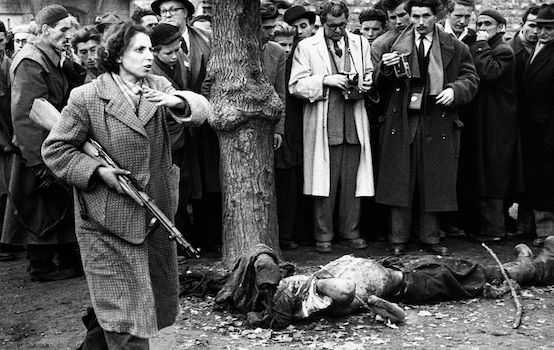A female Hungarian resistance fighter carries a gun during the Hungarian Revolution of 1956 in Budapest. (Photo by © Hulton-Deutsch Collection/CORBIS/Corbis via Getty Images)
BUDAPEST, HUNGARY – The Danube cuts through the city—Buda to the left, Pest to the Right, the long gone Austro-Hungarian Empire on either side, stoically represented in the 19th-century Baroque palaces, magnificent parliament, and municipal buildings. But for all of the glory, there are plenty of cuts in different ways. Budapest is a scarred city.
This week, the city is celebrating the 63rd anniversary of the Hungarian uprising against its once-Soviet controlled communist government. For a country that is in every obvious way trying to guide not only its destiny as a nation but its contemporary national narrative, the 1956 revolution is both a moment of pride and a turning point in an otherwise shameful and tragic century.
“It was the single most anti-totalitarian revolution and freedom fight in history,” declared MáriaSchmidt, Hungarian historian and Government Commissioner of the Memorial Year of the 1956 Revolution. Besides “independence, democracy, and freedom,” the revolutionaries were fighting for “national survival,” she said this week to an assembled group of foreign press in Budapest.
“They wanted to convert us into some kind of Soviet man. We wanted to remain Hungarians,” she continued. “That is why they went with their bicycles and their Molotov cocktails to confront the tanks.”
And for 12 days they did. From October 23 to November 4, 1956, the armed revolutionaries surprised the Soviets and the Communist Hungarian Army soldiers in the streets of Budapest and in the neighboring suburbs. They brought down Soviet tanks and statues of Josef Stalin, and engaged in rigorous shootouts across the city.
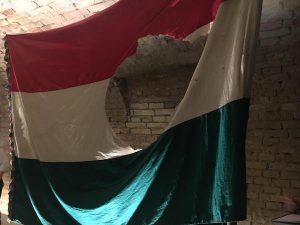
Soviet reinforcements were eventually brought in to crush the opposition. When the dust settled, nearly 700 had been killed on the Soviet side, with more than 2,500 dead among the revolutionaries (and civilians). The fearsome communist police went into overdrive, rounding up some 26,000 people, imprisoning 13,000, and executing 229, including the leader of the uprising, former prime minister Imre Nagy.
Some 200,000 Hungarians then fled the country, leaving their possessions behind. While the uprising is said to have led to a “loosened” occupation, a “Goulash Communism” until the fall of the Iron Curtain in 1990, Soviet troops continued to occupy Hungary. Anyone even tenuously connected to the revolution was surveilled, persecuted, blacklisted, and haunted by government agents through the mid-1960s.
But nothing was entirely the same. The armed resistance had sparked something. “Sometimes you have to lose the battle to win the war,” said Schmidt. “1956 strengthened us.”
It is a story fit for a Netflix drama, and for the Hungarian people, who celebrated the uprising as a national holidayon October 23, it is patriotism distilled and justified. But the road to 1956 is complicated and dark. Furthermore, the tipping point of anger was not only about the loss of national identity, as Schmidt suggests, but the decades of desperation and violence leading up to it. Schmitt should know. The museum for which she became the founding director sits at ground zero for two totalitarian occupations in Hungary—Nazi and Soviet—as well as the reckoning of Hungary’s past.
♦♦♦
The aptly named House of Terror Museum is located in a 19th-century mansion on the grand Ambrossy Boulevard in the central district of Budapest. In the late 1930’s it became the official headquarters of the Arrow Cross, the fascist Hungarian party that the Nazis later put in power when they occupied the country from October 1944 to March 1945.
The entrance to the museum is grim: 3,600 black and white portraits of people who suffered confinement and torture in this building at the hands of the Arrow Cross and Soviet-backed Hungarian police line the walls from floor to ceiling, which are all gray and black. In the foreground is a Soviet T-54 tank. In each room, the timeline unfolds.
Hungary had been collaborating with Adolf Hitler and the Nazis since 1938, hoping to reclaim the 70 percent of territory carved away from Hungary as punishment for fighting with the Germans in World War I. Hungarians were sent to fight with the Nazis in Russia and Yugoslavia and back home, new laws began segregating Jewish-Hungarians. Upwards of 20,000 foreign-born Jews were expelled from Hungary and later killed at concentration camps during the this period under pre-Arrow Cross regent Admiral Miklos Horthy.
Though well on the way to losing the war, the Nazis invaded Hungary in 1944 giving the Arrow Cross power, leading to the murders of some 400,000 Hungarian Jews by 1945, either through direct slaughter in the streets or expulsion to the camps.
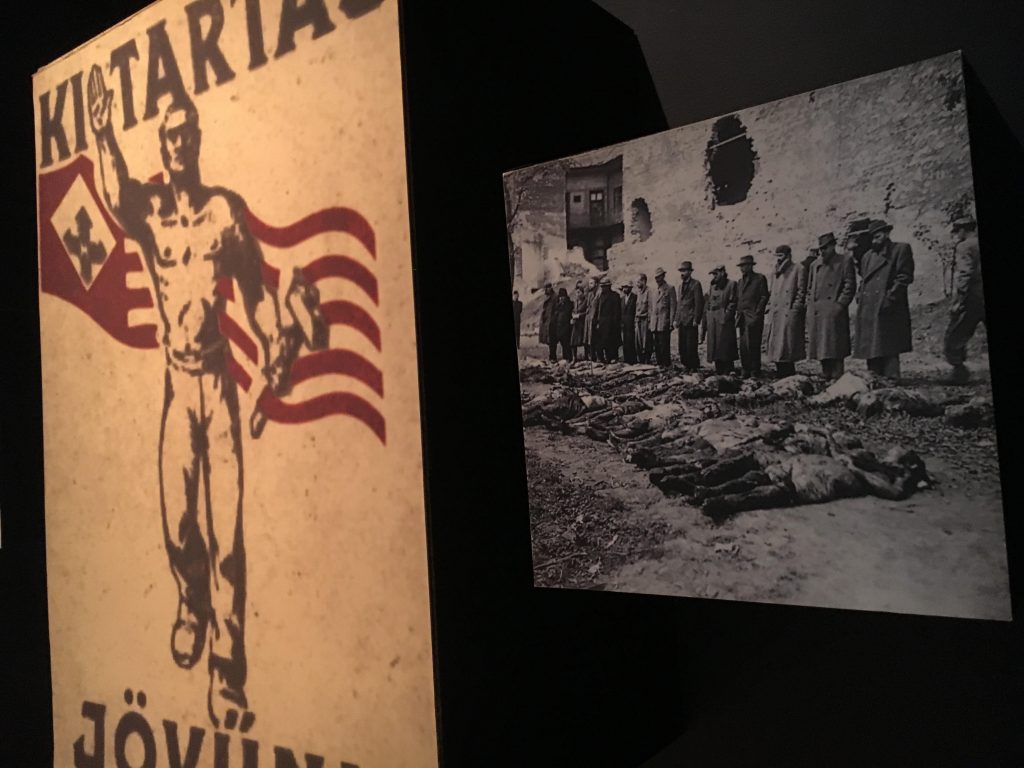
According to Gábor Deák, founder of the Hungarian Jewish Cultural Association and curator of the Lauder Javne Jewish Community School, the war nearly destroyed the country’s Jewry. Surviving Jews from then on complete hid or renounced their faith. It wasn’t until the 1980s that Jewish Hungarians began to form their own organizations and talk publicly about them. Deák was 18 years old when he found out he was Jewish. “I was the first to use the term ‘secretive Jew,’” he said. “Jewish Hungarians turned away from their faith and kept silent on their traditions.” There were less than 11,000 (o.1 percent) self-declared religious Jews in Hungary as of the 2011 census. The country is predominantly Christian (over 52 percent), and of that group, Roman Catholic (37 percent).
The Soviets arrived in 1945 to “save” Hungary (one out of 10 Hungarians perished during the war) and did not leave until 1990. They installed a tyrannical Communist Party regime that ruled the decimated population through fear and intimidation with the aid of the security forces, which took over what is now the Terror House Museum (the previous Arrow Cross occupants were the first to be purged and executed).
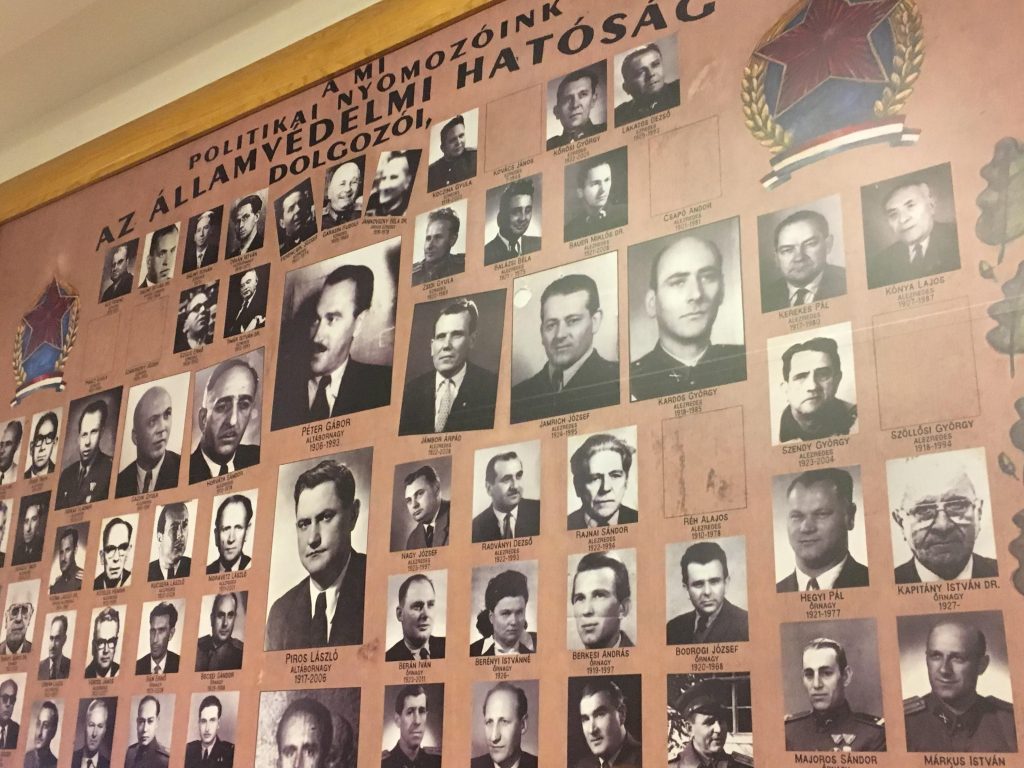
Run by former Budapest tailor and communist activistGábor Péterfrom 1945 to 1952, the Soviet-backed State Protection Authority became a “terror outfit” that, through a series of purges in the early years, “reduced people to subjects: thousands of citizens feared them, and they in turn, feared each other. If ordered to do so, they killed without hesitation or on the strength of confessions extorted during brutal interrogations” after which they sent their victims to the gallows, prisons, or labor camps in Russia, according to the museum’s literature. They did this through a web of informants and a surveillance apparatus eerily presaged by George Orwell in Nineteen Eighty-Four.
The exact room where the show trials took place is now covered wall to ceiling with the bogus files used to prosecute the victims. Screens broadcast actual footage from the nationally televised trials. “They wanted to kill these people” so they gave Hungarians a show, said Katalin Hollósy, a museum tour guide whose grandfather was sent to the Gulag in Russia during this period. “There was no equality under the law.”
From the courtroom, the party’s victims were taken down to the cells far below the fine Andrassy Boulevard address. Today, it is still dank, the tiny dirt-floor chambers more dungeons than “jails.” A ghastly room with one foul toilet stands in for the latrine and shower area. Torture tools are strewn across a table. “I think the atmosphere stayed here,” Hollósy comments, as she takes the hushed visitors through the narrow passages.
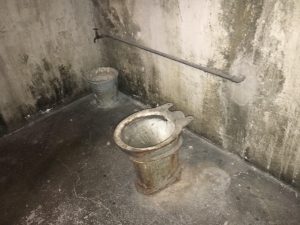
By the time the group gets to room commemorating the 1956 uprising, there is a sense of relief and pride, but even that is bittersweet. Here, there is a wall with hundreds of portraits of Hungarians who had collaborated with the fascists and communist occupiers. Many, judging from the dates under their photos, were alive when the museum opened in 2002. Yet none were ever brought to justice. According to Hollósy, most melted back into society after 1990, the country too ashamed and devastated to do more than try and pick up the pieces.
♦♦♦
“Picking up the pieces” has meant becoming part of the European community again. It has meant joining NATO in 1999 and the European Union in 2004. But domestically, after 1990, “shock capitalism” upended the economy. The country was then dealt another blow in the world financial crisis of 2008, which it is still struggling, many say successfully, to claw back from.
Today, as Hungary finds its fiscal feet, they are positioned to challenge their European partners on the cultural front. If one listens to Schmidt and other government officials, their fight is with Western Europe, mainly Brussels, which they see as “applying different norms, double standards” to countries that hew to the liberal internationalist orthodoxy. Hungary is now deliberately opposing that orthodoxy by pushing a more nationalist message.
“We are not a dictatorship,” said Schmidt, assumedly referring to the Article 7 measures the EU is now debating that could lead to sanctions against Prime Minister Viktor Orbán’s government, charging him with dismantling the rule of law relating to Hungary’s media and independent court system. “We just had elections, and our elections are free. Why do we have to be harassed? We do not need to be lectured.”
For many Hungarians (there are still over a million living in Romania and Slovakia, which acquired those lands after World War I), modern history flows from the 1920 Treaty of Trianon, through all of Hungary’s sins and miseries, the 1956 uprising, and into the present day. There, Orbán and his right-wing populist Fidesz Partyare trying to bring the country back to its pre-world war sovereignty and vitality, albeit through a self-described modern “center-right” Christian nationalist government.
The narrative is everything. For conservative Hungarians, there seems to be no interest in rewriting the past, or playing down Hungary’s role in the Holocaust. These are scars that will take time and honesty to heal. Instead they want to address the thousand cuts they say they receive every day from Western Europe. They want to explain directly why Orbán’s insistence on throwing up walls against mass Islamic migration and promoting pro-family government legislation to rebuild the economy and birthrate is the best path for Hungary today.
Looking at the 5 percent economic growth,record low unemployment, higher wages, and slowly increasing birth rate, it would seem that something is working, though skepticism abounds. Critics point to serious worker shortagesas one fallout of Orbán’s staunch anti-immigration policies.
Meanwhile, the conservatives’ pursuit of national pride and sovereignty gels with that of other populist, national movements across Europe. It’s also opened up an alliance between Orbán and President Trump, who sees the Hungarian’s traditionalist agenda and resistance to Brussels as complementary to his struggles against the liberals in Washington and in Europe.
Not every Hungarian, especially in the urban centers, agrees, as we saw in the losses at the ballot box in last week’s elections. Largely seen as a backlash against Orbán, whether it be to his country-wide consolidation of Fidesz-friendly media or what is seen as “illiberal policies”towards academia and non-Christian institutions, the results had government officials in spin mode this week. They point out that Orbán’s party still holds a healthy two-third’s majority, and that really, this is how a true democracy works. They blame, too, Brussels’ influence on the world media, poisoning the well.
♦♦♦
After 46 years of submission to foreign tyrannies and nearly three more decades of economic depression, Hungary is poised for a return. The Terror House, for all the criticisms, is a chance for Hungarians not only to learn and remember, but to own what happened and to heal. Such “healing” can be seen, at least superficially, in the new economic gains, the rehabilitated prize buildings and architecture, increased tourism, and fresh construction in Budapest. Even in the new Jewish organizations that Gábor Deák spoke about.
While outsiders from the Left want to see Orbán as the new Ferenc Szálasi, and the Right want to revive what they see as the country’s proud Christian identity, only Hungarians themselves can decide who they want to be now. At least they know who they don’t want to be. And that’s the best start they’ve had in a century.
Kelley Beaucar Vlahos is executive editor at TAC. Follow her on Twitter @Vlahos_at_TAC.

